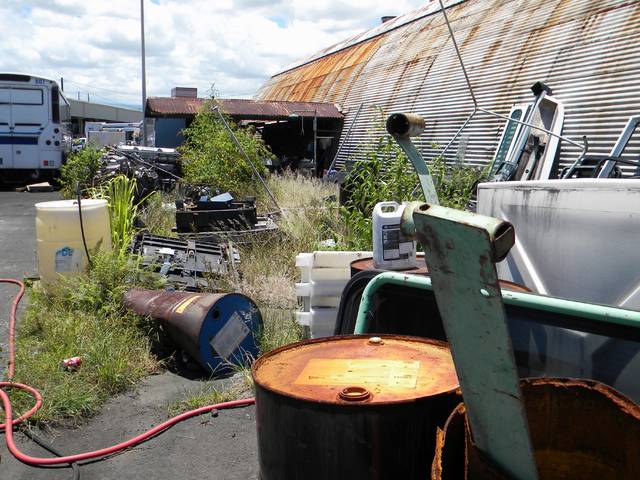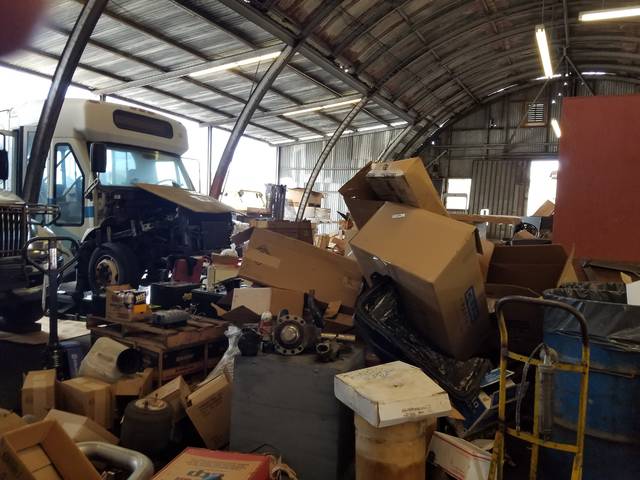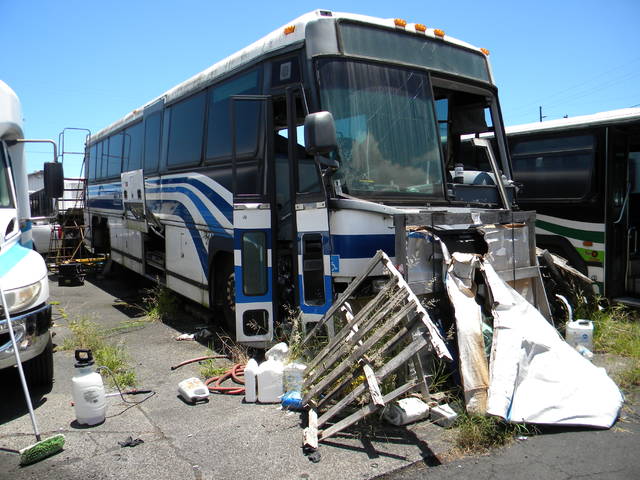Mass Transit baseyard in mass disarray
At the Mass Transit baseyard, there’s a virtual junkyard of dead and dying buses awaiting work. Some have become places to lean dozens of tires, others are draped with trash, hoses and mops.
ADVERTISING
Behind the shed where mechanics work, weeds thread their way through discarded engines and other vehicle parts. Rusting 50-gallon drums, broken glass and plastic containers litter the ground and stacks of window frames are leaned against the shed.
Inside, it’s even worse. Empty cardboard boxes are scattered hither and yon, vehicle parts are lying haphazardly on the floor and desks are covered with papers and rags. There’s barely room to walk.
Now county officials are trying to figure out how the wheels came off an agency that one County Council member calls a “critical link” to the community.
The disarray at the baseyard reflects the management disarray of a department that’s been trying to hold itself together with almost half of its fleet out of service. The situation has reached a crisis point, but it’s been building up a long time.
Mayor Harry Kim, who took over the county’s top office in December, is trying to get a handle on the situation. Transit Administrator Tiffany Kai is stepping down, and a consultant on an 89-day contract takes over Monday until a more permanent administrator is hired.
Kim, shown photos of the baseyard Thursday, wasn’t happy about what he saw. After confirming with Kai the interior of the shed still looks as depicted in a Sept. 24 photo, Kim said he’s ordered the mess cleaned up immediately. He said he was told the mess has been building up “over the past few months” because the staff has been so busy.
“I find it hard to comprehend,” Kim said. “This is unacceptable.”
Hilo Councilwoman Sue Lee Loy, who is recommending an audit of the agency, said her concerns have only grown since she quizzed Kai during a budget presentation earlier this month. While a consultant is scheduled to complete a $500,000 Mass Transit master plan in February, there are more rudimentary actions that need to be taken first, she said.
“The study is steps six through 10,” Lee Loy said. “We need to do steps one though five first.”
The master plan was the brainchild of former Puna Councilman Danny Paleka in response to community concerns.
The disarray is also an indication of a breakdown of the controls normally in place. Unlike almost all other county departments, Mass Transit, with a $13.8 million budget, 13 full-time employees and a host of contract bus drivers, is headed by a civil service administrator, instead of a mayoral appointee.
Under the county code, it’s advised by a nine-member Transportation Commission. But commissioners have long complained their role has been limited to approving taxi licenses and their attempts to get the Hele-On bus service on the agenda have been blocked by administration.
“I don’t claim I know the answer but I do know there’s a problem,” Commissioner Ken Obenksi said Friday, acknowledging that “running a city bus service in a rural environment is a challenge.”
The county’s 55-bus fleet is down to just 25 working buses because of engine problems and other malfunctions. That’s making it difficult to cover 23 routes.
The problem has been compounded because the baseyard, which shares limited space with the Public Works Automotive Division at the Schultz Siding facility on East Lanikaula Street, has grown too crowded for the growing Hele-On bus service.
The county is building a big new bus baseyard out past the Hilo landfill, but the $12 million facility, originally scheduled to open in November, hasn’t been completed yet.
The project was delayed after a contractor excavated too much rock and soil, requiring it to be back-filled with concrete. Completion is now slated for mid-May, a Public Works spokesman said Thursday.
Obenski said the conditions at the baseyard may have deteriorated as staff waited expectantly for their new digs.
Among the broken buses at the current lot is a double-decker bus, added to the fleet with great fanfare in 2011.
Since last May, the $900,000 vehicle has sat in the maintenance yard, awaiting parts that probably won’t be purchased until July.
“There is a transmission problem with the vehicle. Part of the electrical harness was damaged from an exhaust leak,” Kai said in an email Tuesday. “We had a transmission tech come to take a quick look, but once the fiscal 2018 funds kick in (July 1), we will be able to bring the trans tech over here to find the short and to replace the harness.”
The agency’s $13.8 million budget is projected to rise 6 percent next year. Federal grants account for just $1.2 million of the budget, and with fares accounting for $960,000, the county pays an average $11.77 per rider. Riders pay $1-$2 fares.
Kim has high hopes for his new troubleshooter, Curtis Sharp, a retired Marine.
“We will do an analysis and we will fix it,” Kim said. “We will fix this.”





